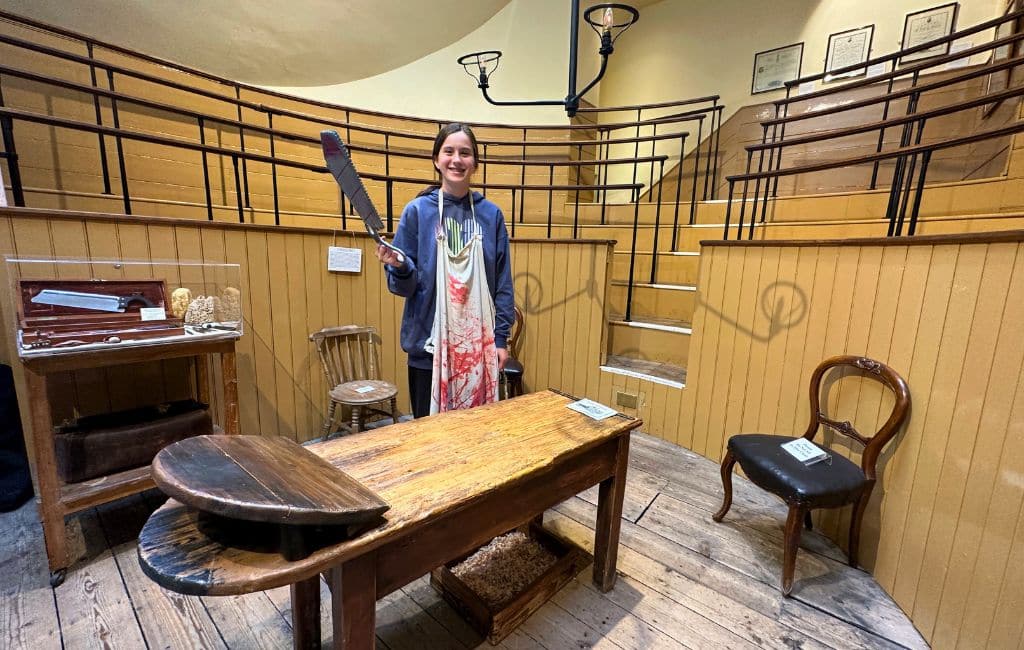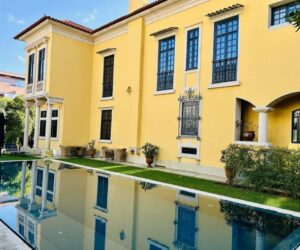London is full of quirky places to visit, curious sights and unusual museums but one of my favourites is the Old Operating Theatre Museum.
Located in London Bridge, around the corner from Borough Market and in the shadow of the Shard, is a centuries-old church and the location of one of the city’s most unique attractions.
London’s Old Operating Theatre Museum & Herb Garret is the oldest surviving surgical theatre in Europe and one of London’s best hidden gems. Here’s what to expect when you visit.
Disclosure: This post may contain affiliate links. I have been or could be if you click on a link in this post compensated via a cash payment, gift or something else of value for writing this post. See our full disclosure policy for more details.


A Brief History of London’s Old Operating Theatre
The Old Operating Theatre Museum & Herb Garret sit in the attic of St Thomas’ Church. No-one quite knows when a church was first built here but the current church was constructed between 1698 and 1702 and formed part of St Thomas’ Hospital.
The hospital once occupied an extensive space, stretching from Borough High Street to where the Shard stands today and from St Thomas’ Street to Tooley Street. It was organised around three interconnected courtyards with buildings that were three storeys high.


When the church was rebuilt it was fitted out with a large garret, a habitable attic, using original timber beams from the original church. The attic space was used to dry and store herbs that were later made into medicines for use in the hospital.
The hospital treated the poorest of patients with separate sections for men and women; the mens wards were located closer to where the Shard now stands and the women’s wards were near to Borough Market, and wall to wall with St Thomas’ church.
There was already an operating theatre in the men’s wards but there wasn’t one for women and operations on female patients took place in women’s wards, surrounded by patients.


In 1822 an operating theatre was installed in the garret as a space to both operate on female patients and to train new surgeons. The theatre had space for around 100 students who could stand and observe as the poor female patient lay on the operating table and underwent surgery.
Only three types of surgeries were performed here: trephination, a surgical procedure that involves drilling a hole in the head to relieve pressure from bleeding or swelling; removing bladder stones and amputations.


Remember that this was a time before anaesthetics were invented; pain relief was limited to alcohol, opiates and chloroform – and a wooden cane to bite down on!
The old operating theatre closed in 1862 when St Thomas’ Hospital moved to a new site in Lambeth. The theatre was sealed up and abandoned until it was rediscovered in 1956. It reopened as a museum in 1962 and today offers a unique insight into this period of London’s medical history.


Visiting the Old Operating Theatre Museum
Access to the Old Operating Theatre Museum is via the eighteenth-century church of the Old St Thomas hospital, up a 52-step narrow spiral staircase. At the top of the stairs is the ticket booth and a small shop and behind this is the Herb Garrett.


The Herb Garrett
The attic room is filled with old surgical tools, apothecary jars, dried herbs and information about the history of medicine from medieval times through the Victorian era. It’s a fascinating place to discover and you could easily spend hours exploring the atmospheric museum.
Highlights when we visit included the baskets of dry herbs including burdock root, hibiscus flower and raspberry leaf, the many glass apothecary bottles and old ceramic medicine jars.
I particularly enjoyed the glass cabinet dedicated to Victorian medicine for women that includes nerve tablets, rhubarb pills and blood and stomach pills.
There are lots of gruesome-looking medical instruments on display, including a collection of metal hooks and forceps once used in childbirth alongside medical books with detailed illustrations. There are also cabinets dedicated to surgical equipment with some terrifying knives and saws on display.
The attic space is divided into sections and each one has information panels so it’s easy to enjoy the museum on self-guided walking tours. If you did want more information, the museum often offers tours and talks led by volunteers or historians.


The Old Operating Theatre
Today, the theatre is Europe’s oldest surviving surgical theatre but I still find it extraordinary that the theatre was sealed off and abandoned for so long.
It was only rediscovered in 1956 when the organologist and antiquarian Raymond Russell was investigating the church’s attic. Tests were carried out when it was rediscovered, including archaeological studies on the floorboards where they discovered a layer of sawdust beneath the operating theatre floor that was once used to ensure blood didn’t seep through to the church below.


The theatre was designed with semicircular seating – or stands – so that medical students could have a clear view of surgical procedures being performed on the central operating table. The table sat underneath a large skylight that surgeons, in the absence of modern lighting, had to rely on to get light when performing their operations.
Visitors today can put on a red paint splattered apron, hold a rubber saw and pose at the old operating table (something that my daughter reluctantly did!) but the theatre is also used for talks, including an always-popular talk on the history of surgery and the Victorian operating theatre.
Visiting the Old Operating Theatre with kids
The operating theatre might sound a little gruesome but actually it’s a fantastic place to visit with kids. Not only is it a fascinating insight into the history of modern medicine but it’s a very hands-on museum, perfect for curious children. Plus, the museum often hosts family-friendly activities during the school holidays.
How to Visit the Old Operating Theatre & Herb Garrett
The Old Operating Theatre Museum is located at St Thomas’ Church, 9a St Thomas Street, SE1 9RY. The closest tube station is London Bridge station.
Note that the museum can only be accessed by a 52-step spiral staircase, which is so narrow that it can only accommodate one person. A traffic light system at the top and bottom of the stairs lets you know when it’s your turn to go! There is no elevator and there are no public toilets onsite.
The museum is open Thursday to Sunday, from 10:30am to 5:00pm, with last admission at 4:15pm.
Admission prices: Adults £9, Concessions (students, seniors, disabled) £7, Children (6-16) £5.50, under 6 free. There is also a Family ticket.
Book ahead: Tickets can be bought in advance online and it’s worth booking in advance if you are visiting during holiday periods.






